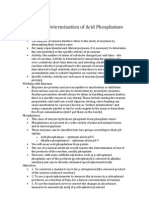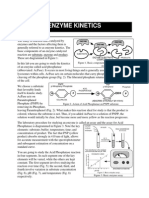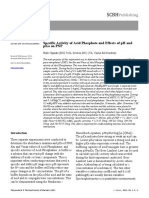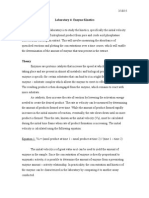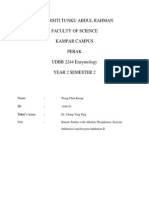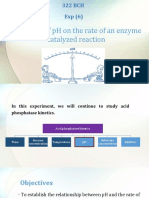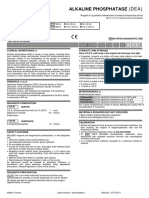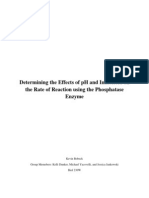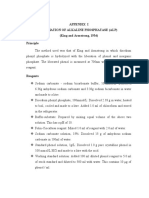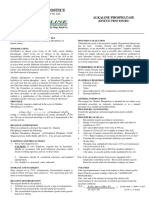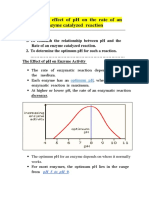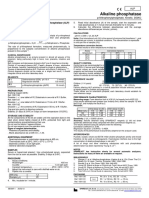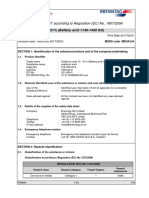Laboratory Class 3: Enzymes 2025
PROCEDURES
Several aspects of the kinetics discussed above will be studied in this lab session, using a
commercial acid phosphatase preparation from wheat germ. First of all, you will investigate the
time dependence of the enzyme catalysed reaction. Following measurement of the initial rates
of reaction with fixed amount of phosphatase and variable concentrations of substrate in the
presence and absence of an unknown inhibitor, Lineweaver-Burk plots will be constructed, and
KM and Vmax will be determined from these plots. The analysis of the effect of the inhibitor on the
kinetic parameters of the enzyme will allow you to identify the type of inhibitor that you have
used.
EXPERIMENT #1: Rate of product formation
As pointed out in the discussion of initial velocity the acid phosphatase assay must be carried out
under conditions where the rate of product formation is constant over the incubation period.
This is critical because the assay is a fixed time assay, and the enzyme is subject to product
inhibition. In order to check the rate of product formation, a time curve will be constructed. Each
student will use different amounts of enzyme, thus with the results of the whole group, you will
be able to analyze the dependence of the enzyme activity on the enzyme concentration.
In this experiment, you will be handling a rack with assay tubes, a water bath, a 1 mL pipette, a
vortex, solutions of Na-Acetate and KOH at room temperature, solutions of PNPP and acid
phosphatase on ice, a beaker with water and a stopwatch. First, organize your working area. For
instance, if you are right-handed, you may dispose the pipettes and solutions on the right side of
your station, whereas you will keep the rack with tubes, the vortex and the water bath, on the
left and center-back of your station.
1. Prepare and label 6 test tubes, each containing 2.0 mL of 0.5 M KOH. Label them: 0, 2, 4,
6, 10 and 15 (corresponding to the point times of the assay).
CAUTION: This is a concentrated solution of a corrosive base that can irritate your skin
and eyes. Wear gloves and safety glasses. For more info, consult the MSDS.
2. Pipet into a 7th tube (tube R) the proper volumes of 1.0M sodium acetate buffer (pH 5.7)
and water corresponding to your workspace dataset as described in Table 2. Mix with the
vortex.
54
� Laboratory Class 3: Enzymes 2025
Table 2: Reaction mixtures with variable enzyme amount (tube R)
Team number
Reagent
1,9,17 2,10,18 3,11,19 4,12,20 5,13,21 6,14,22 7,15,23 8,16,24
1.0M Na-Acetate, pH 5.7 (mL) 0.5 0.5 0.5 0.5 0.5 0.5 0.5 0.5
H2O (mL) 3.9 3.8 3.7 3.6 3.5 3.4 3.3 3.2
0.5 mg/mL Acid phosphatase (mL) 0.1 0.2 0.3 0.4 0.5 0.6 0.7 0.8
20mM PNPP (mL) 0.5 0.5 0.5 0.5 0.5 0.5 0.5 0.5
Total volume (mL) 5.0 5.0 5.0 5.0 5.0 5.0 5.0 5.0
3. Add the corresponding volume of acid phosphatase solution (0.5 mg/mL) to the same
tube R. Mix and pre-incubate at 37°C for two or three minutes to pre-equilibrate the
temperature before the reaction is initiated.
4. Initiate the phosphatase reaction by adding 0.5 mL of 0.020M PNPP to tube R.
Immediately mix and transfer 0.5 mL to the tube 0. The KOH that was added to the tube
0 will stop the reaction. Mix well and let the tube stand at room temperature. (This is the
ZERO time sample. There is zero substrate conversion, so the reading represents the
background absorbance of the reaction mixture).
CAUTION! PNPP and PNP solutions may irritate skin and eyes. Both products
are toxic if absorbed through the skin. Use gloves and safety glasses.
http://www.neb.com/nebecomm/MSDSFiles/msdsP0757.pdf
http://ccinfoweb2.ccohs.ca/rtecs/Action.lasso?-database=rtecs&-layout=Display&-
response=detail.html&-op=eq&RTECS+NUMBER=SM2275000&-search
5. Withdraw 0.5 mL aliquots from the reaction mixture, tube R, at times 2, 4, 6, 10 and 15
minutes and transfer each of these aliquots to the appropriate test tube from step 1
containing 2.0 mL of 0.5 M KOH. Mix well and keep the tubes 2, 4, 6 etc at room
temperature, but keep the tube R always at 37°C. (Each tube 2-15, represents the amount
of substrate conversion at the corresponding time).
6. Measure the absorbance of each tube 0-15, at 405 nm, zeroing the instrument on water.
55
� Laboratory Class 3: Enzymes 2025
7. Subtract the reading for the time ZERO sample from all readings. Enter the absorbance
values into Table 4. Using an Excel spreadsheet, plot your corrected absorbance values
versus time (minutes) and verify whether the reaction is linear over a period of 10
minutes. Estimate the slope of the linear range of your plot.
8. From all plots in the group, your TA will select an enzyme concentration which will yield
a constant rate of product formation over a period of 10 minutes (see information in
dataset). You will use the same concentration (but different amount) for experiment 2.
EXPERIMENT #2: Determination of KM and Vmax
As previously mentioned, the catalytic properties characteristic of an enzyme, reaction rate and
specificity, are manifested in the two kinetic parameters KM and Vmax. In this experiment you will
measure the two kinetic parameters of acid phosphatase. For the determination we will assume
that the enzyme follows the Michaelis-Menten equation where the initial velocity is a function of
the substrate concentration. Keeping the same enzyme concentration, you will measure the
initial velocities corresponding to different concentrations of the artificial substrate PNPP, in
optimal acid pH. Since you have already determined in Experiment 1 the concentration of enzyme
for which the formation of the product PNP is linear with time beyond 10 min, you can easily
determine the initial velocity by measuring the amount of product obtained after 10 min
incubation with that amount of enzyme.
NOTE: The final volume of the reaction for experiment 1 is 5 mL whereas for this experiment
2 is 0.5 mL, therefore you must add 10 times less enzyme.
As for experiment 1, the amount of product is measured by reading the absorption of the
solution at 405 nm. As usual, a blank is required to estimate the background absorption of the
reaction mixture in the absence of product formation. To this end, a series of reaction mixtures
are prepared (ZERO time tubes) where the stopping solution (KOH) is added before the enzyme
and thus no reaction takes place (Figure 4).
56
� Laboratory Class 3: Enzymes 2025
Figure 4: Kinetics experiment
57
� Laboratory Class 3: Enzymes 2025
Before you start pipetting, fill the cells with brackets in Table 3 and show these figures to your
TA. The concentration of acid phosphatase solution was decided at the step 8. Calculate the
amount for the new volume. The amount of water can be calculated from the amount of enzyme
and a total incubation volume of 0.5 mL. The final concentration of PNPP substrate can be
calculated from the amount of PNP added and the incubation volume.
9. From a stock solution of 20 mM PNPP, prepare three 0.5 mL solutions of 0.5, 2.0 and 5.0
mM PNPP in water. (For the 0.5 mM solution, the error will be lower if you use either the
2.0 mM or the 5 mM solutions instead of the 20 mM stock).
10. Label one set of 7 test tubes from 1 to 7 (incubation tubes) and another set of 7 test tubes
from 1Z to 7Z (ZERO time tubes).
11. Add to both series of tubes the corresponding volumes of water, Na-acetate buffer and
PNPP solutions as indicated in Table 3. Vortex all tubes.
12. Pre-incubate the incubation tubes for 2 min at 37°C (To make sure that the reaction takes
place at that temperature).
Table 3: Reaction mixtures with variable [PNPP]
Tube number
Reagent
1 2 3 4 5 6 7
H2 ( ) ( ) ( ) ( ) ( ) ( ) ( )
1.0 M Na-Acetate, pH 5.7 ( L) 50 50 50 50 50 50 50
50 ----- ----- ----- ----- ----- -----
2.0 ----- 25 50 ----- ----- ----- -----
----- ----- ----- 50 75 ----- -----
20 ----- ----- ----- ----- ----- 25 50
0.5 ( ) ( ) ( ) ( ) ( ) ( ) ( )
Time enzyme addition 0 min 1 min 2 min 3 min 4 min 5 min 6 min
Time KOH (2 mL) addition 10 min 11 min 12 min 13 min 14 min 15 min 16 min
Incubation time (min) 10 10 10 10 10 10 10
PNPP concentration (mM) ( ) ( ) ( ) ( ) ( ) ( ) ( )
13. Add 2.0 mL of 0.5 M KOH to each of the time ZERO tubes. Vortex and leave at room
temperature.
14. Add the amount of enzyme indicated in Table 3 to each of the time ZERO tubes. Vortex
and leave at room temperature.
58
� Laboratory Class 3: Enzymes 2025
15. Initiate the reactions by adding the volume of the enzyme solution to the incubation
tubes at the time indicated in Table 3. Mix well (vortex) after the addition.
16. Stop the reactions, after 10 minutes of incubation, by adding 2 mL of 0.5 M KOH to each
of the incubation tubes, at the time indicated in Table 3. Mix well and let the tube stand
at room temperature.
17. Read the absorbance in all tubes at 405 nm. (Zero the instrument with water).
18. The time ZERO readings are the blank readings (background absorbance without any
enzymatic reaction). Subtract the corresponding time ZERO reading from each incubation
reading.
EXPERIMENT #3: Inhibitor
Repeat experiment 2 but now in the presence of an inhibitor. For the setup of the incubation
tubes (Figure 4), modify Table 3 by decreasing the water in all L from that shown
8.5mM solution of the unknown inhibitor before the enzyme.
Since the inhibitor does not absorb at 405 nm, you do not need to repeat the series of time Zero
tubes. For the correction of absorption by the blank, you will use the values obtained in
experiment 2.
CAUTION: the inhibitor may be toxic!
(Take note of the number of your inhibitor).
59
� Laboratory Class 3: Enzymes 2025
RESULTS AND DISCUSSION
Rate of product formation
R1. Convert the corrected absorbances from step 7 into amounts of PNP. In your
calculations, you should assume a molar absorptivity for PNP of 1.88x104 M-1cm-1 ( 405),
a path length for the cuvette of 1 cm and a final assay volume of 2.5 mL (This final
volume takes into consideration the 2 mL of KOH that was added for stopping the
reaction). From the volume of the incubation mixture (0.5 mL aliquot: before the
addition of KOH) and the substrate concentration, calculate the percentage of substrate
converted. Show your calculations for a given time. From the concentration of the
provided stock solution of enzyme, calculate the concentration of acid phosphatase in
your assay. Summarize your results in the following Table 4.
Table 4: Time dependence of product formation
(Acid phosphatase in the assay: mg/mL)
Percentage of
Time (min) A405 PNP(mM) PNP (( mol ) PNPP
converted
0
2
4
6
10
15
R2. Plot the amount of product ( mol PNP) versus time (minutes) for your results in Table
4. Estimate the initial velocity of the reaction. For how long does the reaction rate
remain constant? Indicate the highest level of substrate conversion (in %) that you can
observe in the linear range. Can you explain why plots sometime deviates from the
straight line (reach a plateau)? N.B. Since you are looking to show the relationship
between two quantitative variables (amount of PNPP and time), the data will have to be
plotted as a scatter plot (and not a line graph). A scatter plot graph will allow you to
easily add a trendline on the linear range of your data (see Tutorial on how to add a
trendline on a linear portion of a graph on Brightspace).
60
� Laboratory Class 3: Enzymes 2025
Determination of KM and Vmax
R3. Use the [PNPP] values calculated for Table 3. Convert the corrected absorbances from
step 19 for both experiments 2 (control) and 3 (inhibitor) into amounts of PNP as above.
Calculate the corresponding reaction rates (v). Show all your calculations for one
substrate concentration for the control (exp. 2). Summarize your results in two tables
(Table 5/6) with the following format:
Tables 5/6: Substrate dependence
Control (experiment 2) Inhibitor (experiment 3)
[PNPP]*
[PNP] PNP v [PNP] PNP v
(M) A405 A405
(M) ( mol) ( mol/min) (M) ( mol) ( mol/min)
* Initial concentration of substrate
R4. From Tables 5/6 complete Table 7 for the analysis of results by the Hanes method, a
linear form of the kinetic equation. Show all your calculations for one substrate
concentration for the control.
Table 7: Data for the use of the Lineweaver-Burk equation
Control Inhibitor
[S]*
V 1/V 1/[S] V 1/[S]
(M) 1/V ( mol/min)-1
( mol/min) ( mol/min)-1 (M)-1 ( mol/min) (M)-1
* Initial concentration of PNPP
R5. From Table 7, construct the Lineweaver-Burk plot for the enzyme in the presence and
absence of inhibitor. (Prepare one graph with the two Lineweaver-Burk plots. Draw for
each plot the best-fit straight line, also called the linear-regression trend line).
61
� Laboratory Class 3: Enzymes 2025
R6. From the linear equations of the two best-fit lines found in your Lineweaver-Burk plot,
determine the KM and Vmax parameters corresponding to each condition. Show your full
calculations for the control plot. Summarize your results in Table 8. Indicate the type of
inhibitor that you have used. Justify your answer. Remember to use a 25% cut-off for your
inhibitor identification (please see Appendix C4 for information on how to calculate the
percent difference).
Table 8: Kinetic parameters obtained from experiments 2 and 3
Control Inhibitor
Vmax Vmax
Method
( mol/min KM (M) ( mol/min KM (M)
ou U) ou U)
Lineweaver-Burk
R7. From the value of Vmax and KM for the control and the inhibitor (according to Table 8)
and from Table 1, estimate the constants KI and/or KI
your inhibitor and summarize your results in Table 9. Show an example of your
calculations.
Table 9: Type of inhibitor
Inhibitor Type of
[I] (M) Vmax (U) KM (M) KI (M) KI
number Inhibitor
------- 0
R8. From the estimated value of Vmax for the control (according to Table 9) and the protein
concentration of the provided enzyme solution, calculate the specific activity of your
phosphatase sample in U/mg. (Hint: the estimated Vmax is the activity corresponding to
the amount of enzyme that you used in the assay for experiment 2).
62
� Laboratory Class 3: Enzymes 2025
REFERENCES
1. Fersht A. (1977). Enzyme Structure and Mechanism. Freeman (NY) p 84.
2. Voet, D. and Voet, J. (2004). Biochemistry, 3 rd Ed. John Wiley & Sons, 14.2, p 477.
3. Cornish-Bowden, A. (1995). Fundamentals of Enzyme Kinetics. Portland Press (London).
P 27.
4. Lineweaver, H. and Burk, D. (1934). J. Amer. Chem. Soc., 56: 658.
5. Hanes, C.S. (1932). Biochem. J., 26:1406.
6. B.H. Hofstee, (1952). On the Evaluation of the Constants Vmax and KM in Enzyme
Reactions. Science 116: 329.
7. Voet, D. and Voet, J. (2004). Biochemistry, 3 rd Ed. John Wiley & Sons, 14.3, p 482.
63
